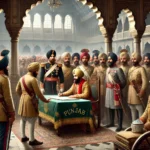PAK YATRA is a tour operator company providing tour services and facilitates Sikh community from different parts of the world.
Detailed History of Shahi Masjid Chitral
Importance of the Place:
Shahi Masjid Chitral stands as a magnificent piece of architecture and a symbol of cultural heritage in the Chitral District of Khyber Pakhtunkhwa, Pakistan. As the main mosque in the town of Chitral, it serves as a center of worship and a testament to the region’s rich history and architectural tradition.
Story Behind:
Built in 1924 by Shuja ul-Mulk, the ruler of Chitral from 1895 to 1936, Shahi Masjid Chitral is a remarkable example of architectural prowess and cultural patronage. Constructed with pure white marble and adorned with intricate engravings, the mosque reflects the cultural and artistic aspirations of Chitral’s aristocracy during that era.
Location:
Shahi Masjid Chitral is situated in the Chitral District of Khyber Pakhtunkhwa, Pakistan, at the geographic coordinates of approximately 35°51’20″N latitude and 71°47’22″E longitude. It is located on the bank of the Chitral River, adjacent to the historic Chitral Fort, further enhancing its significance within the local landscape.
Preservation Efforts:
Efforts to preserve the architectural integrity and historical significance of Shahi Masjid Chitral have been ongoing. As a vital part of Chitral’s cultural heritage, the mosque has been maintained and renovated over the years to ensure its continued prominence as a place of worship and a cultural landmark.
Architectural Marvel:
Shahi Masjid Chitral is celebrated for its stunning architecture, characterized by the use of pure white marble and intricately carved artistry. The mosque’s design embodies the cultural and traditional motifs of Chitral’s aristocratic heritage, making it a standout architectural marvel within the region.
Historical Evolution:
Constructed approximately 100 years ago during the tenure of Shuja ul-Mulk, Shahi Masjid Chitral has witnessed the historical evolution of Chitral as a center of cultural and religious significance. From its inception to the present day, the mosque has remained a focal point for worship and a symbol of Chitral’s enduring legacy.
Background:
The construction of Shahi Masjid Chitral by Shuja ul-Mulk in 1924 reflects the architectural and cultural legacy of the region. As the ruler of Chitral during that period, Shuja ul-Mulk’s patronage of the mosque exemplifies the intersection of power, culture, and religion in shaping the identity of Chitral.
Historical Significance:
Shahi Masjid Chitral holds immense historical significance as a revered place of worship and a symbol of Chitral’s cultural heritage. Its association with Shuja ul-Mulk and its proximity to the historic Chitral Fort further elevate its importance within the local community and among visitors, highlighting its enduring legacy as a cherished monument of architectural and cultural significance in Khyber Pakhtunkhwa, Pakistan.




